Smarter Benefits, Less Hassle
Your benefits admin solution shouldn’t hold you back. bswift empowers your HR team and employees with an intuitive solution that simplifies benefits. Experience seamless processes, personalized interactions, and higher engagement, all supported by our dedicated team. You deserve easy, effective benefits administration. It’s time for a smarter, more personalized solution.

Achieve Better with bswift

Enhance Employee Experience
Navigating benefits shouldn’t be difficult – for your employees or the HR teams supporting them. bswift’s comprehensive employee benefits platform creates a simple, straightforward way to learn about, select, and manage benefits for employees and their families.

HR AI: New Study Reveals AI’s Potential for the Employee Experience
A recent bswift-commissioned Forrester study reveals that AI isn’t just another fleeting trend in the HR landscape – it’s a catalyst for change.

Flexible and User-Friendly: bswift Benefits Enrollment Solutions
Learn how bswift’s benefits administration platform streamlines HR’s work with flexible technology, seamless customization, and user-friendly tools to deliver benefits the way they’re meant to be.

Boost Operational Efficiency
Streamlining your teams’ workload is more important than ever. We simplify processes and make it easier for HR teams with human-focused HR solutions. Our flexible benefits administration platform seamlessly integrates with your current environment, saving time, reducing costs and minimizing risk.

AI for HR: 4 Key Trends You Need to Know Now
Cut through the hype. From Mindful AI to people analytics, these 4 trends in AI for HR boost employee engagement and attract top talent.

Ditch the Stress: How bswift Makes Benefits Administration Easy
bswift’s innovative platform takes the hassle out of benefits administration. See how we empower HR with user-friendly tools to help deliver benefits.

Streamline Benefits Administration
Take difficult high-touch tasks like retirement administration, HSA, billing, and compliance and let bswift handle them for you. Our innovative technology and benefits expertise streamline administration and enable you to focus on your people.

bswift Delivers a Stellar Annual Enrollment
Stress-free annual enrollment starts with bswift. Explore our infographic for HR tech, stellar service, and employee satisfaction at light speed!

Toyoda Gosei Customer Story
Hear how bswift’s benefits tech stands out for its robust functionality, flexibility and dependability in managing complex benefits for a diverse workforce.

Strengthen Internal Communications
Effective communication is key to engaging employees. The bswift Engagement Agency designs strategies to improve how employees engage with their organizations. Using personalization tools that meet employees where they are, we ensure they are well-informed on the latest at your organization, whether it’s their benefits and annual enrollment, or other internal initiatives.

Solving the Employee Communication Puzzle: Tips for Better Engagement
Effective employee communication is crucial for HR. Learn best practices to improve benefits utilization and employee engagement.

The Winning AE Trifecta: AI, Employee Comms and Human Connection
In this webcast, bswift will explore how HR can optimize annual enrollment (AE). They’ll cover marketing-inspired communication techniques, the role of AI in streamlining HR processes and the importance of the human touch.
All Your Benefits Goals. One Flexible Ben Admin Partner.
Build a better benefits experience and earn employees’ trust. Our integrated and easily configurable benefits solution—designed for your needs.
Explore Our SolutionThe bswift Benefits Ecosystem
Streamlined HR Administration
Innovative administrative HR solutions that leverage advanced technology, efficient processes, and proven expertise to help your organization thrive.
Emma: Support Across the Benefits Journey
Emma™, powered by bswift’s Mindful AI, delivers human-like support throughout the benefits journey, adapting to your employees' needs from start to finish.
Defining Service Excellence
People-first benefits need a personal touch. With decades of experience and tech-enabled service, we empower your people, your business, and your community.
Personalized Employee Engagement
Boost employee health and wellbeing with our intuitive employee engagement solutions. Personalized processes maximize their benefit utilization.
Meet Emma
bswift uses Emma to provide personalized support. Emma is powered by Mindful AI™, which blends human sensitivity with advanced intelligence to ensure every interaction is both empathetic and effective.
Emma EnrollPro™ is an intelligent and personalized guide to simplify benefits selection for employees.
Emma Chat is like speaking to a top-tier support expert – anywhere and anytime.
Emma Agent Assistant analyzes call and chat dialogue in real time, offering tailored guidance based on plan details.
Clients that Trust in bswift
“A few words to describe the bswift technology: Flexible, customizable, user-friendly. Their ability to customize solutions for our complex organization really made a difference for us. I’ve truly enjoyed the partnership with them.”
-VP of Health and Welfare, Omnicom Group
bswift by the Numbers
bswift invests in people and technology to create better experiences for all of those we serve.
View our Mission
lives covered and experiences enhanced with bswift

Customer Service Transformation Award

Technology Excellence Award for Best Advance in Benefits Administration

Of clients retained due to our dedication to innovation and service
Social Feed
What's New

The Employee Engagement Crisis: 4 Ways HR Leaders Can Improve Morale and Productivity
Discover four strategies HR leaders can use rebuild clarity, foster connections, create meaningful growth opportunities and boost employee engagement.

HR Trends That Will Define 2025: Rising Costs, Smarter Benefits Strategies
Discover the HR trends shaping 2025, from skyrocketing healthcare costs to smarter benefits strategies. Learn how to stay ahead and support your team.

bswift Delivers a Stellar Annual Enrollment
Stress-free annual enrollment starts with bswift. Explore our infographic for HR tech, stellar service, and employee satisfaction at light speed!

The Rising Impact of Diabetes on Workplace Productivity and Employee Health
Support employee health and reduce costs with effective diabetes management programs that promote workplace wellness and enhance productivity.

Values in Action: How Company Culture Drives Business Success
Here's how strong company culture, driven by core values, improves employee engagement and business success. Learn how to strengthen culture.
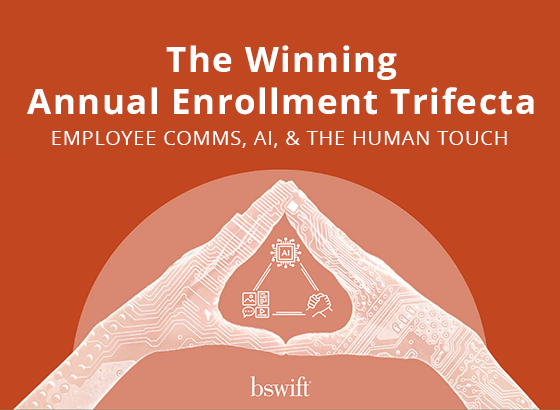
The Winning Annual Enrollment Trifecta
Our annual enrollment infographic unlocks the power of effective communication, AI, and human expertise for a seamless benefits experience.

AI for Health Plan Administration: 3 Ways It’s Transforming Benefits Management
AI is transforming benefits administration. Discover how bswift's Mindful AI™ enhances human abilities, improving efficiency, accuracy, and user satisfaction.

The Winning AE Trifecta: AI, Employee Comms and Human Connection
In this webcast, bswift will explore how HR can optimize annual enrollment (AE). They’ll cover marketing-inspired communication techniques, the role of AI in streamlining HR processes, and the importance of the human touch.

Conquer Annual Enrollment: 7 Steps to Scale Your HR Everest
Master annual enrollment with our checklist. From HR tech to communication planning, streamline your HR process and improve your employee benefits rollout.

bWise – Ep 30: Emma™ Asks the Experts: The Future of AI in Benefits Administration
Join hosts Don and Sharon as they explore the latest AI enhancements to bswift’s groundbreaking AI-powered platform intelligence, Emma.

4 Holistic Health Trends to Boost Employee Wellbeing and ROI
Learn how holistic health trends in employee wellbeing programs like value-based care, whole person care, mental health can boost ROI.

Flexible, Powerful, Trusted: bswift Redefines Benefits Admin
Hear why HR pros choose bswift for benefits administration. See why organizations of all sizes trust bswift to deliver efficiency, flexibility, and advanced functionality in benefits tech.

AI for HR: 4 Key Trends You Need to Know Now
Cut through the hype. From Mindful AI to people analytics, these 4 trends in AI for HR boost employee engagement and attract top talent.

Harnessing the Power of AI for HR
Unlock AI’s potential in HR with bswift: Automate tasks, enhance decision-making, and focus on strategic goals. Discover AI’s role in recruitment, onboarding, and more

bWise – Ep 29: Building the Future of HR with AI: A Chat with Jeff Kirk
Get practical insights for driving successful digital transformations across industries. Listen in as Jeff Kirk shares his 20+ years of experience and wisdom, with real-world examples of digitizing businesses

Employee Healthcare Cost Containment Strategies: A Guide for HR
Rising healthcare costs got your HR team down? Discover 4 data-driven cost-containment strategies from bswift's IX to reduce healthcare spending & improve wellbeing.

Harnessing the Power of AI for HR – Make it Mindful
Leverage AI for HR with bswift's Mindful AI approach. See how AI enhances human expertise, recruiting, onboarding, engagement and compliance.

The Gold Standard in Employee Comms: bswift Communication Agency
bswift Communication Agency wins 2 Gold Hermes Awards for creative employee benefits communication. Learn more about our award-winning work!

Introducing the AI Supercharged Emma™: Your Employee Benefits Guide
Empower your employees with bswift's Emma, an AI-powered benefits assistant. Personalized recommendations, plan comparisons and more.
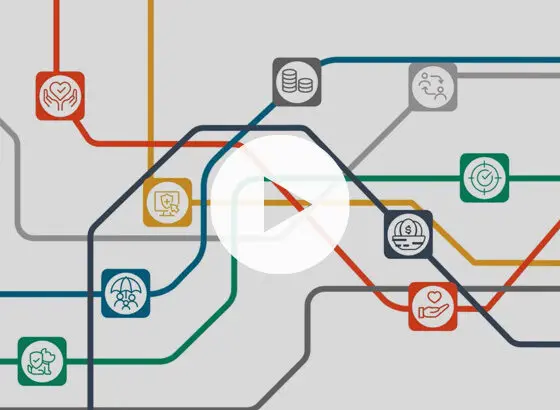
Simplify Benefits, Unlock HR’s Potential: bswift Has You Covered
Simplify benefits administration and empower HR with tools to streamline enrollment, optimize benefits use, and free HR for strategic work.

Solving the Employee Communication Puzzle: Tips for Better Engagement
Effective employee communication is crucial for HR. Learn best practices to improve benefits utilization and employee engagement.

bWise – Ep 27: Streamlining Benefits Admin: Real-World Wisdom from Industry Vet Maria Yao
The latest episode of the bwise Podcast is a masterclass in optimizing operations. Tune in for Maria’s straight-shooting advice and elevate your operational capabilities.

Flexible and User-Friendly: bswift Benefits Enrollment Solutions
Learn how bswift’s benefits administration platform streamlines HR’s work with flexible technology, seamless customization, and user-friendly tools to deliver benefits the way they’re meant to be.

Ditch the Stress: How bswift Makes Benefits Administration Easy
bswift’s innovative platform takes the hassle out of benefits administration. See how we empower HR with user-friendly tools to help deliver benefits.

bWise – Ep 26: Achieving Liftoff: Lana Hillebrand’s Journey From Astronaut Aspirations to HR Industry Leader
In this episode, hosts Don and Sharon sit down with HR and benefits administration leader Lana Hillebrand, who recently joined bswift’s advisory council.

Optimize Benefits Enrollment: HR Best Practices for the ‘So-Called’ Off-Season
Benefits enrollment best practices for HR. Improve employee communications strategies, analyze benefits utilization and enhance benefits portfolios.

bWise – Ep 25: Navigating the Future of Ben Admin: A Conversation With Scott Millson
On this episode, benefit administration insider Scott Millson shares his unique perspective on his over three decades in the employee benefits field.

American Heart Month: How to Support the Heart Health of Your Workforce
February is American Heart Month – the perfect time to focus on workplace wellness and heart health through personalized digital tools and connected capabilities.

Choosing Your Benefits with Ask Emma
Choosing Your Benefits with Ask Emma Video Transcript

The Future of HR: 4 Trends Reshaping Employee Benefits in 2024
Let's look at the future of HR, from AI and automation to cost containment, tailored well-being initiatives, and adapting to remote work.

bWise – Ep 24: Ice Baths to Client Service Excellence: A Conversation With bswift COO Amit Jain
Listen in as bswift Chief Operating Officer Amit Jain talks about his passion for client service, his unique approach to leadership, and his vision for the future of benefits administration technology.

Paycor Channel Partner Story
Learn how the expertise, seamless integration, and customer-focused approach of benefits admin platform bswift supports Paycor. Watch Video.

NFP Channel Partner Story
bswift combines technology, flexibility, and support to meet NFP's diverse client needs with a user-friendly interface and exceptional client collaboration.
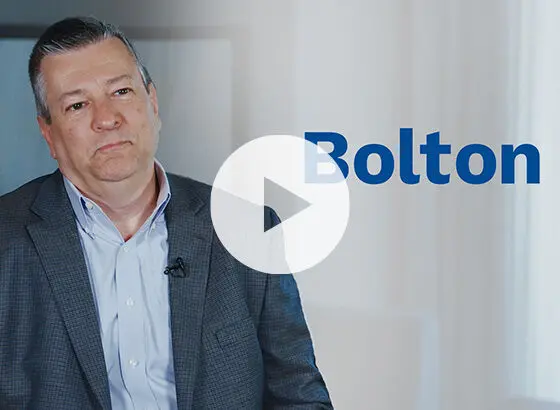
Bolton Channel Partner Story
Bolton partners with bswift for an intuitive, user-friendly benefits platform and exceptional support. Watch video now.

How to Improve Employee Benefits Engagement
Boost employee benefits engagement with proven HR strategies like clear communication, feedback loops, and AI chatbots to empower employees

bWise – Ep 23: Shaping Culture and Service: A People-First Approach to HR with bswift’s Natalie Atwood
bswift’s Chief People Officer Natalie Atwood talks with bWise hosts Don and Sharon about her passion for putting people first.

bswift Elevate™: Empowering Holistic Employee Wellbeing, Anywhere and Anytime
bswift Elevate is reimagining the employee well-being journey and simplifying the employee experience with hyper-personalized messaging to drive deeper engagement in employer wellbeing programs.

The bswift Service Center Commitment Video
Benefits can be difficult to understand. Watch this video to see how bswift's Service Center makes it simpler for employees.

Want Engaged Employees? Show Full Value with Total Compensation Statements
A smart way to boost employee engagement is to create a total compensation statement that details the value of their salary, benefits and other rewards.
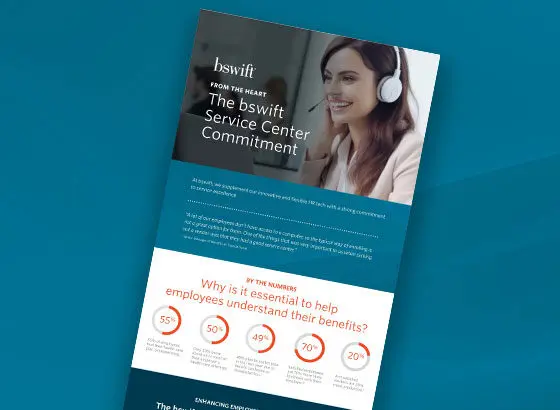
The bswift Service Center Commitment
At bswift, we supplement our innovative and flexible HR tech with a strong commitment to service excellence.

Toyoda Gosei Customer Story
Hear how bswift’s benefits tech stands out for its robust functionality, flexibility and dependability in managing complex benefits for a diverse workforce.

GXO Customer Story
See how bswift’s flexible solutions and services helped GXO quadruple their benefits enrollment rate. Watch Video here.
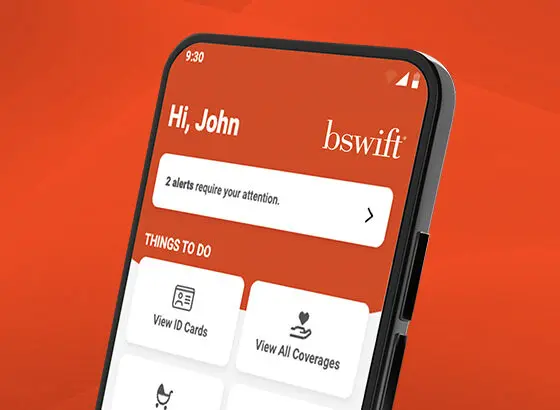
bswift Mobile App: Empower Your Employees
The bswift Mobile App offers your employees seamless access to their benefits. Download the app now via the App Store or Google Play Store.

Omnicom Group Customer Story
See how bswift’s flexible solutions and services helped Omnicom navigate their complex benefits administration needs. Watch now!
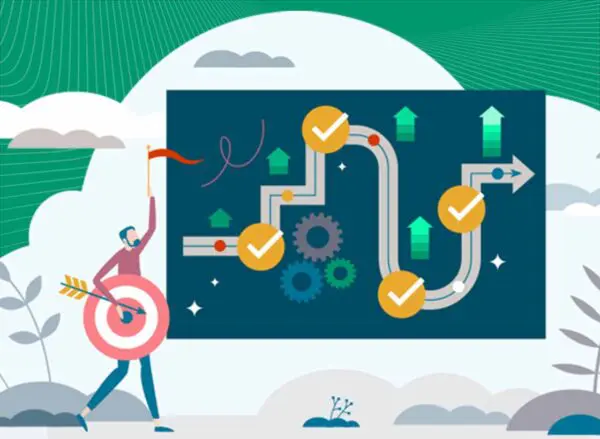
Ace Annual Enrollment: 4 Solutions to Common HR Challenges
Make annual enrollment frictionless and empowering, These tips will help you optimize the employee experience and drive talent retention.

Unlocking the Power of Employee Benefits
Discover the hidden keys unlocking the full value of your benefits program for your employees and your organization. Watch it now!

Prioritizing Employee Wellbeing for Business Success
Explore the core connection between employee benefits, employee wellbeing, and business success. Get a roadmap for reviewing your organization's current offerings to ensure they're relevant, accessible and effectively supporting workforce health and productivity.
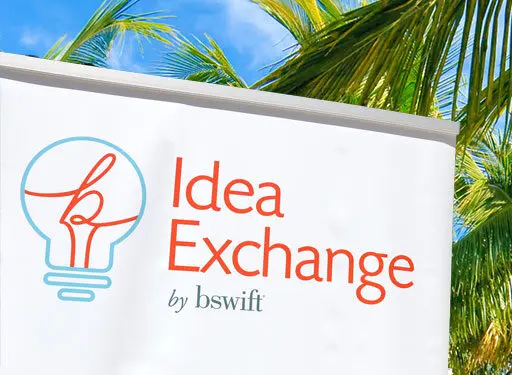
Insights and Highlights: A Recap of bswift’s Idea Exchange 2023 Conference
bswift's Idea Exchange 2023 Conference brings you insights on employee benefits engagement and benefits administration. Access session videos and more. Perfect for any HR professional looking to stay up-to-date.

bWise – Ep 20: Digital Transformation: HR and Employee Engagement, With NFP’s Mark Rieder
In this episode, we’ll explore how digital transformation can improve the employee experience, boost customer satisfaction, increase productivity, and drive greater profitability for the company.
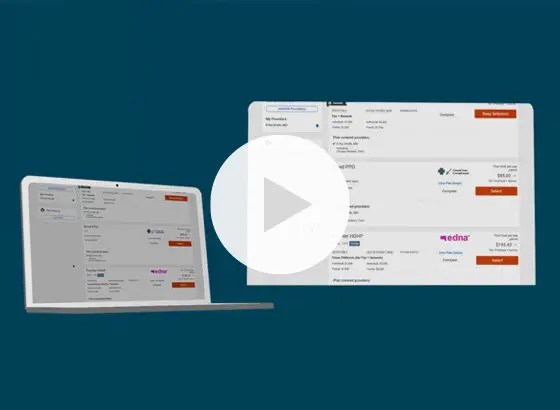
Fueling Outcomes: bswift’s Innovation Strategy and Latest Enhancements
Watch bswift's latest video to get up to date on bswift's latest innovation strategy and enhancements. Watch video now.

bWise – Ep 22: Driving Operational Excellence at bswift With Adam Hostetter
Get an insider’s look at how bswift’s Head of Operational Excellence, Adam Hostetter, is driving major improvements. Learn how his team is enhancing service delivery, upgrading technology, and aligning workstreams to accelerate growth.

Hire Emma: bswift’s AI HR Assistant That Pays for Herself
Meet Emma, the AI HR assistant who resolves benefits questions, provides enrollment guidance, and improves the employee experience.

bWise – Ep 21: bswift’s Bright Future, Mission, and Passion, With bswift CEO Ted Bloomberg
In this episode, you’ll learn more about bswift’s leadership, what fuels our passion for our clients and partners, and our commitment to deliver excellent technology and service to all those we serve.

Here’s How to Create An Engaging Employee Benefits Communication Strategy
Great employee benefits communication is crucial for employee satisfaction. Get tips for effective benefits communications that engage all stakeholders, using a multi-channel approach, incorporating empathy, focusing on timing, highlighting total rewards, and broadening the conversation on employee wellbeing.
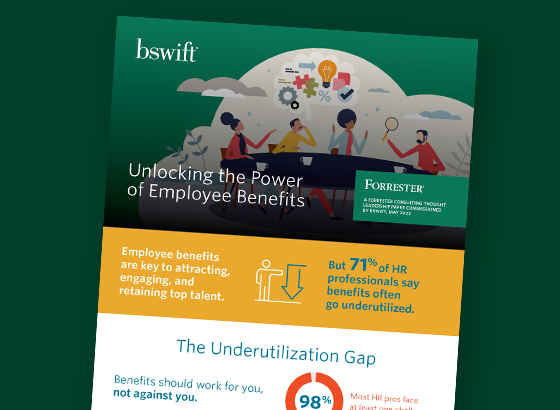
Unlocking the Power of Employee Benefits
Employee benefits are key to attracting, engaging and retaining top talent. Read this infographic to learn more on the underutilization gap

The Power of Effective Employee Benefits Utilization: Tips to Boost Benefits Engagement and Retention
Improve retention, engagement, wellbeing and productivity with an effective employee benefits utilization strategy. Boost benefits engagement with these tips.

Maximizing Employee Benefits Utilization: Challenges and Solutions
Improve engagement and retention with effective employee benefits utilization. Learn common challenges, solutions, and the importance of prioritizing employee wellbeing.

Forrester Research Reveals the High Cost of Low Employee Benefits Engagement (And What You Can Do About It)
Discover how HR pros can improve employee benefits engagement with insights from Forrester Research. Boost morale, productivity and retention, and cut healthcare costs. See the survey results and actionable strategies now.

The Top 5 Employee Benefits to Boost Satisfaction, Retention and Recruitment
Learn which employee benefits matter most to employees, and how these top employee benefits boost satisfaction, retention, and recruitment. A must-read for HR professionals.

How to Use AI to Improve HR: bswift Experts Answer CHROs’ Most Pressing Questions
bswift experts answer CHROs' questions about using AI to improve HR. Learn how to avoid pitfalls, partner with CTOs, and create a better employee experience.

How to Successfully Implement AI in HR: The CTO and CHRO Partnership
Let's look at the benefits and the risks of AI in HR. From data privacy to legal liability, CHROs and CTOs can partner to safely implement AI for business.

Boost Benefits Utilization with a Great Employee Benefits Communication Plan
Unlock the full potential of your employee benefits communication. Benefits U helps you save time and effort and boost employee engagement.

Webinar: Ask the Experts – How to Make AI an Essential Workforce Tool
Artificial intelligence is set to revolutionize the way we manage workforces. Watch our webinar to take your AI knowledge to the next level

ACA Management Suite
Introducing ACA Management Suite, offering a suite of management solutions to help employers navigate the new world of healthcare and benefits

Cut Costs, Not Benefits: Establish a Culture of Health in Your Workplace
Learn how to reduce healthcare costs and improve employee satisfaction with a culture of health in the workplace. Follow these 6 easy steps.

Celebrating Black History Month with Benefits Equity
How you can make the most of this celebration by incorporating employee benefits into your diversity, equity, and inclusion strategy.

6 Great Questions To Help You Measure Annual Enrollment Success
With the dust settling on annual enrollment, it's time to look back and learn. Here are a few simple questions you and your HR team can ask.

The Top 5 HR Trends of 2023: Leveraging Tech to Put the ‘Human’ Back in HR
In 2023, technology will continue to play a major role in how we adapt. Here are the top five HR trends we’re watching in 2023.
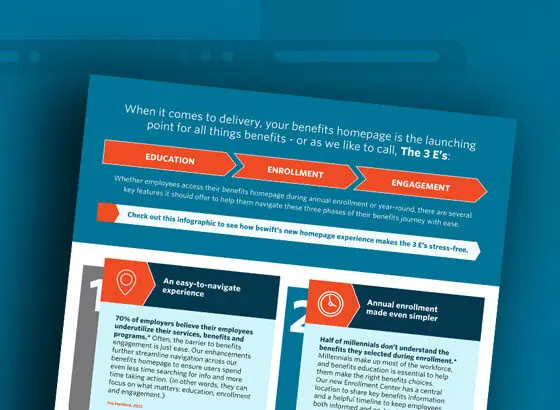
The 3 E’s and bswift’s New Homepage Experience
Your benefits homepage is the launching point for all things benefits, check out this infographic to see how bswift's new home page experience makes the 3 E's stress free.

bswift Dashboard and Reporting
The bswift Dashboard and Reporting tool provides easy access to the robust data you need in customizable reports, all in one location.

Solving the Great Resignation: The role of employee-centric benefits, tech & culture
Struggling to navigate the Great Resignation? Here are a few ways to improve and develop a more employee-centric-culture.

We are bswift
From innovation and data security to compassion and care, hear from our people about what makes us bswift.
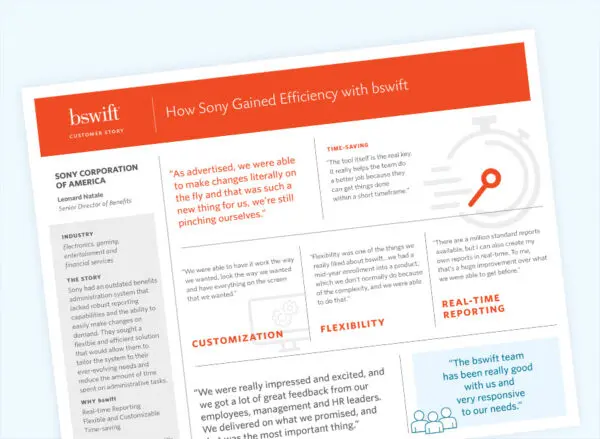
Sony Corporation of America Customer Story
Read how Sony gained efficiency with bswift.
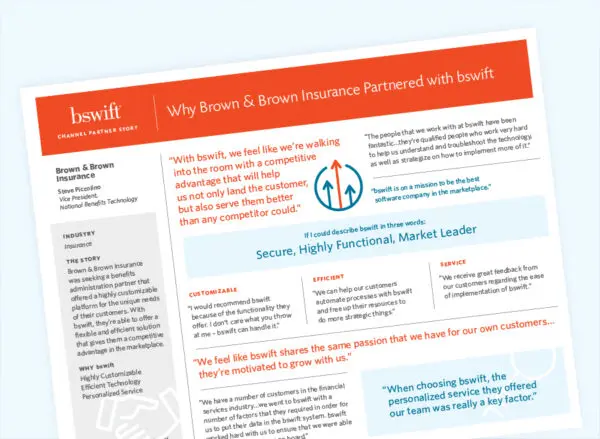
Brown & Brown Channel Partner Story
A bswift Channel Partner Story, on why Brown & Brown Insurance partnered with bswift
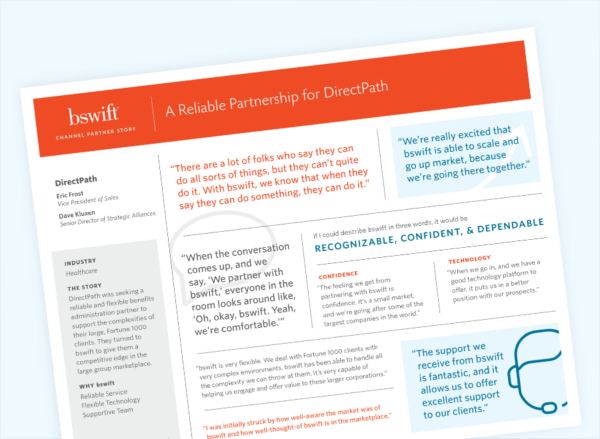
DirectPath Channel Partner Story
A reliable partner for DirectPath, "with bswift, we know that when they say they can do something, they can do it.”
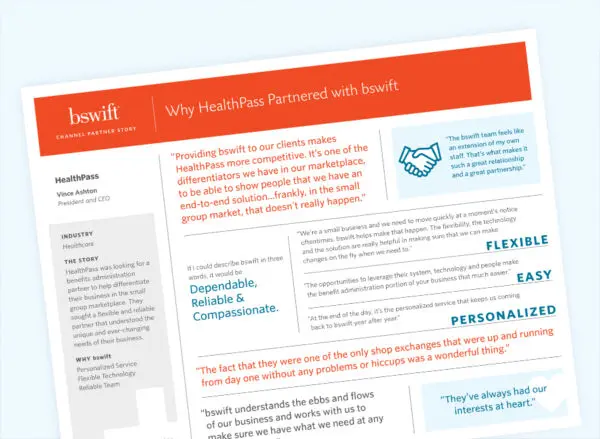
HealthPass Channel Partner Story
Explore why Channel Partner, HealthPass, partnered with bswift to enter the competitive healthcare benefits workspace.
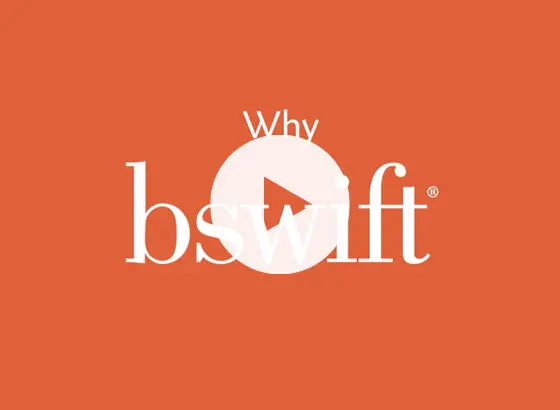
Partner Customer Story
Watch to see firsthand why enterprises across the country choose our bswift platform to transform benefits administration.

Sony Corporation of America Customer Story
Read how Sony gained efficiency with bswift.

ICUBA Customer Story
Watch customer story now

Texas Roadhouse Customer Story
Watch customer story now.

EnPro Industries Customer Story
Learn how EnPro Industries boosted enrollment with bswift.

Holcim US Customer Story
See firsthand how our platform transforms benefits administration.

JELD-WEN Customer Story
JELD-WEN praises bswift's comprehensive system for ease of enrollment, compliance support, and boosting high deductible plan enrollment by over 250%.
Experience bswift in Action
Experience the way benefits are meant to be. Speak with a bswift expert today or book a demo to see our industry-leading benefits administration and AI-powered HR solutions in action.